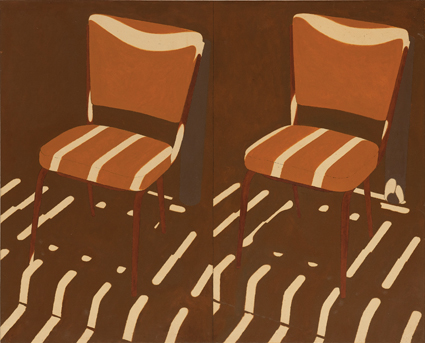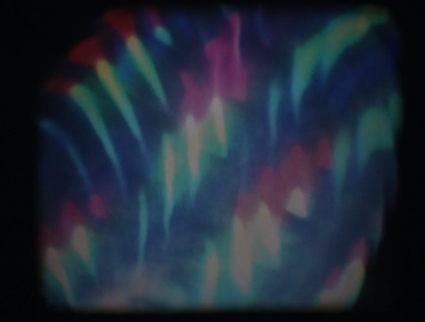The artist handles the world
Danni Zuvela: Tony Woods: Archive

1994 same chair changed light situation, oil on canvas, Tony Woods: Archive
image courtesy the artist
1994 same chair changed light situation, oil on canvas, Tony Woods: Archive
“I rely on film and video to handle reality as my paintings become more abstract.” So says Melbourne artist Tony Woods, and as the new publication surveying his prodigious career, Tony Woods: Archive makes abundantly clear, the artist’s trajectory has indeed been a march from photorealistic figuration into increasing abstraction in paint, with a concomitant moving image practice concerned mostly with imaging “the real.” Only—perhaps typically of Woods’ mercurial style—this statement is also nimbly ambiguous.
The clue is in Woods’ use of the word “handle.” At first we may think of this in terms of its more neutral meaning, “to manage”—Woods uses the moving image, especially in later-life works, for its documentary affordances, to record daily reality. His is a warts-and-all pro-filmic aesthetic, unedited, replete with false starts, slow patches, jerky reframing: Catch as catch can. As Jake Wilson notes, in an especially lovely, perceptive essay in the book, Woods’ starting point is the home movie, and many of the films come across as simple sketches of the artist’s quotidian experience. From his second storey studio vantage point or through a hole in the back fence, Woods frames the passing parade of Fitzroy street life, human and animal, as a way of making sense of the world. This world is people, cats, bugs, flowers, sunbeams, rubbish, textures and patterns, in constant iteration. It’s not always attractive, nor is it meant to be: the alley behind the artist’s studio serves as an outdoor shooting gallery for the area’s notorious junkie population, and through Woods’ fence peephole, we witness their semi-secret abjection rites.
This wretched registry is one of many instances in which we are alerted that this is more than simple diarism at work. As we watch the films, the other meaning of Woods’ statement about using the moving image to “handle reality” begins to emerge. Co-opted into the slow-motion tragedy of street meat, or the futile spasms of a dying honeybee, we realise that this “handling” is manipulating, a sorting of the world around the artist into compositions, which, for all their apparent artlessness, are carefully constructed. This manipulation is obvious, and literal, in the suite of eye-catching films created with homemade kaleidoscopes and re-photography. However, it is just as evident in the street stories and everyday occurrences Woods captures, which disclose a much more deliberate artistic intelligence than the seemingly casual observations might at first suggest.
The chance to see these excerpts from Woods’ films, courtesy of the DVD inclusion, is one of the central joys of Tony Woods: Archive. The combination of these and the documentary, “work for the eyes to do,” provides us with a unique access to the artist’s thinking, significantly complementing the requisite biographical-interpretive essays and beautiful colour reproductions. The thoughtfully produced documentary makes the most of its high production values (great lighting, strong sound, adroit editing). It alternates interview footage of Woods with an array of other talking heads—his peers, art critics, dealers and other observers—and rich imagery of Woods’ works, spoken to by the subjects or the artist himself. Through this and the essay contributions (by Sheridan Palmer, Gary Willis, Lesley Chow, Alex Selenitsch, Phil Edwards and Jake Wilson) we learn about the artist’s early years in Tasmania (and how he still regards himself as Tasmanian, despite being seen by some as the “quintessential Melbourne painter”) and about his progression from early watercolour into acrylic techniques, his fateful New York trip at the height of Pop, return to Australia and immersion in the protean creative juices of the Yellow House. As we are inducted into the developments of the artist’s mature style, it is fascinating to learn about Woods’ parallel practices, not just in film and video but also in field recording, where the sense of the artist “handling” the world through documentation—this time sonic—surfaces again.

Reel Light, film, 1992, Tony Woods
Perhaps the greatest strength of the publication is the diversity of accounts and their presentation. We are drawn into this complex and talented artist’s world, given access to his creative inspiration and evolution, at a deeper level than other modes of artist biography that might sacrifice depth for gloss. Invited to muse on the aesthetic and conceptual relations between the artist’s practice across canvas, celluloid, pixels and audio tape, we start to develop insights into how the dialectic of representation and abstraction powers an artist like Tony Woods, finding varied expression across forms, materials and decades. There is here a play of opacity and porosity that rewards repeat readings and viewings. Tony Woods: Archive, with its detailed understanding of an artist whose work should be more widely known, is a rare and worthwhile addition to the annals of Australian art history.
Tony Woods: Archive, editor Andrew Gaynor, publisher artinfo.com.au, distributor Australian Scholarly Publishing (ASP)
RealTime has 1 copy of the Tony Woods: Archive to giveaway – click here for more info
RealTime issue #117 Oct-Nov 2013 pg. 17






